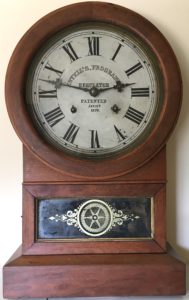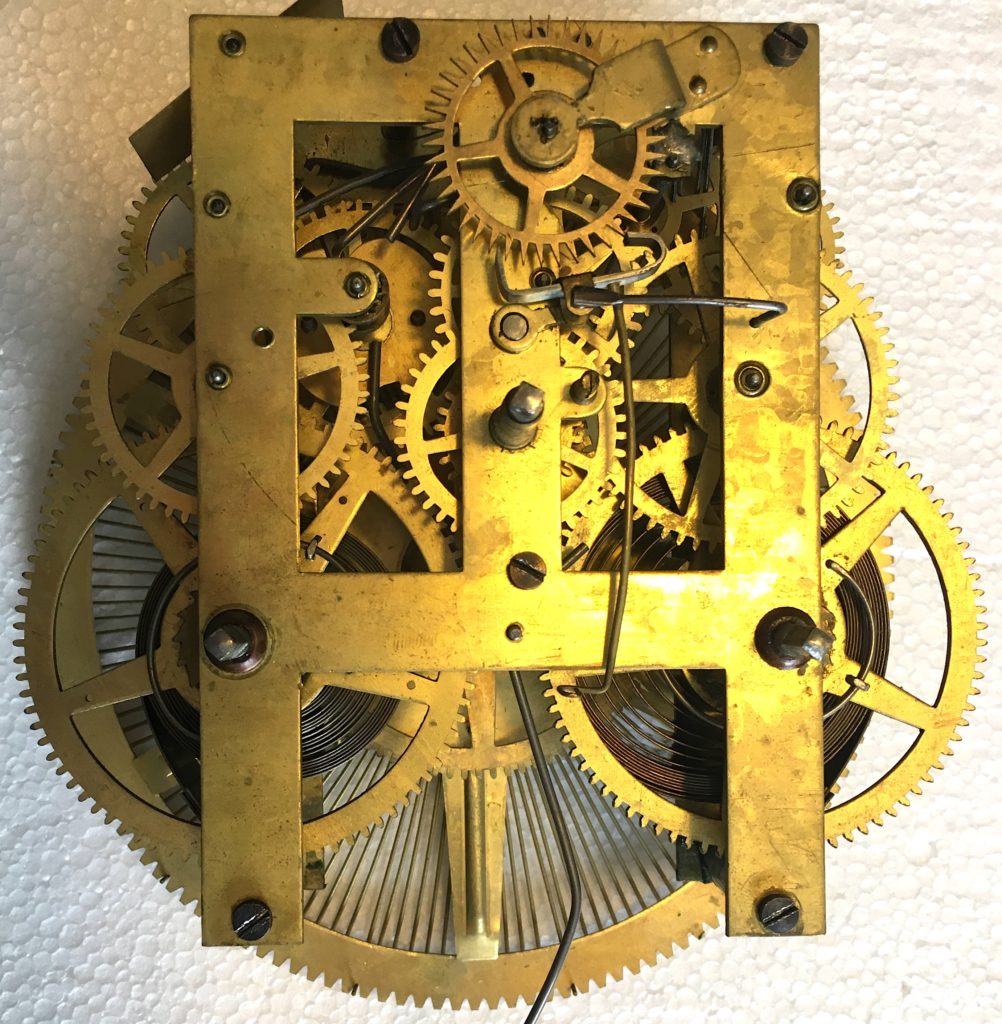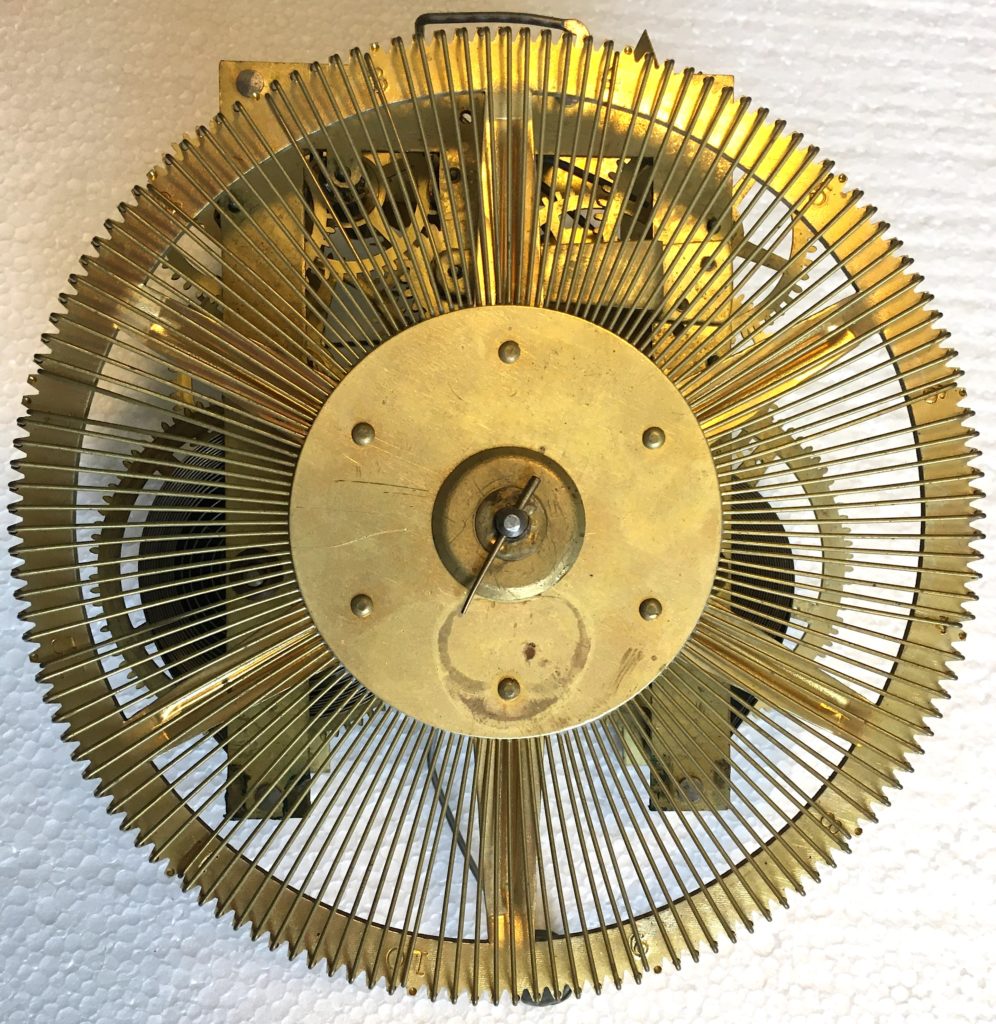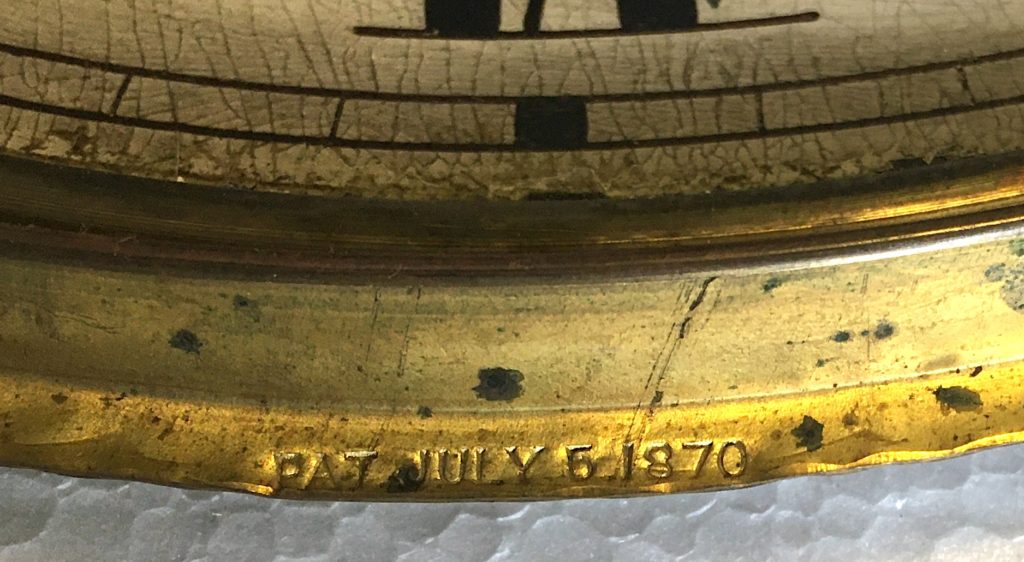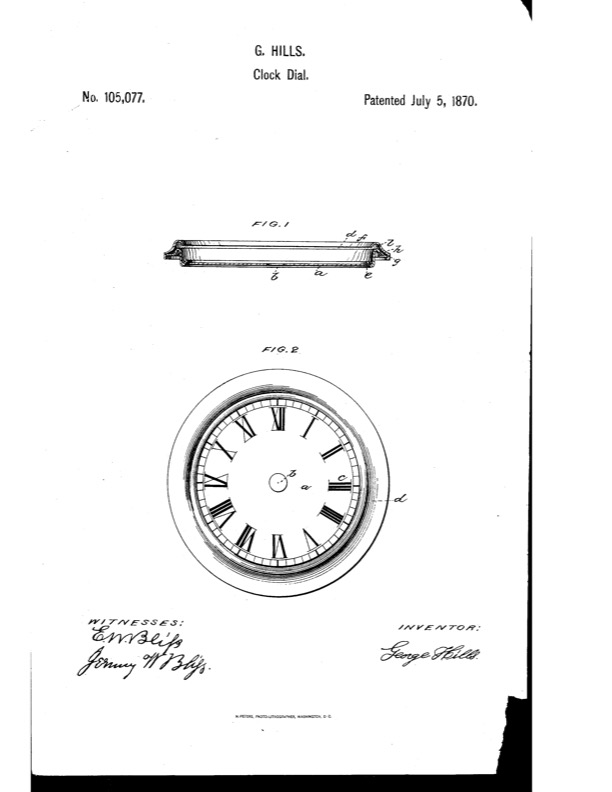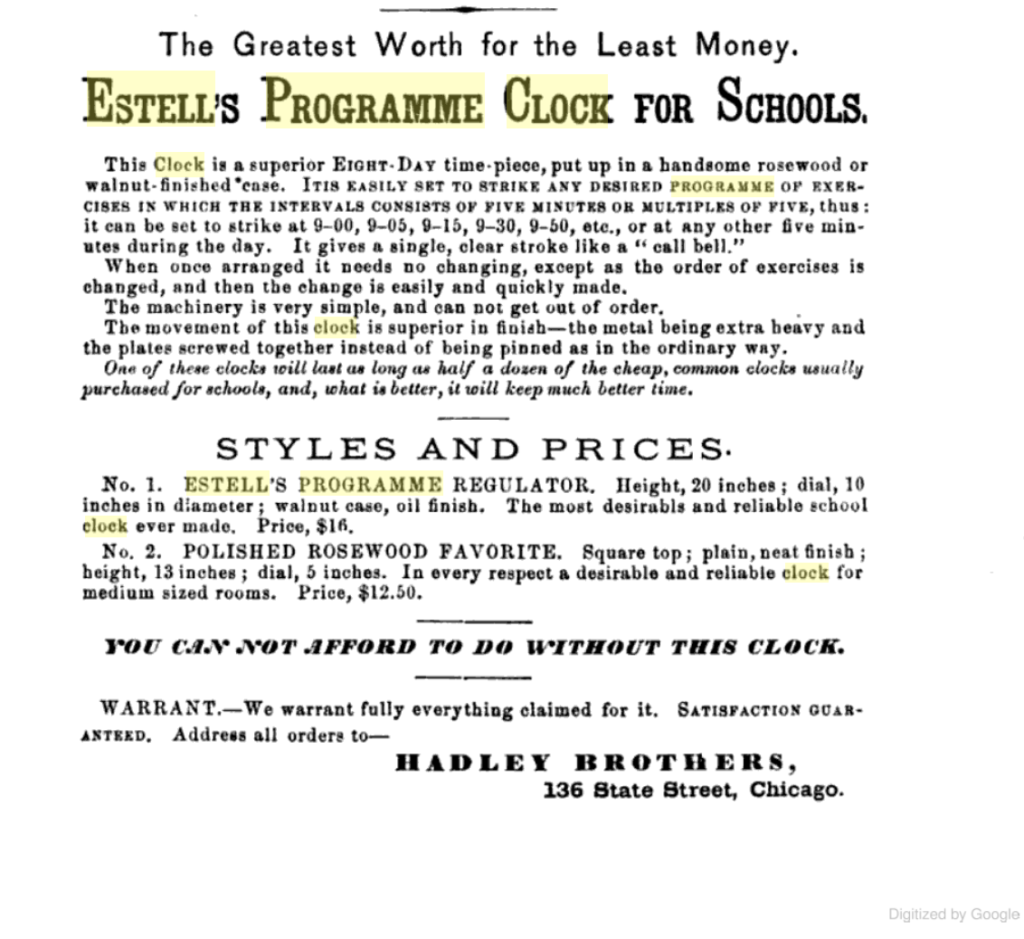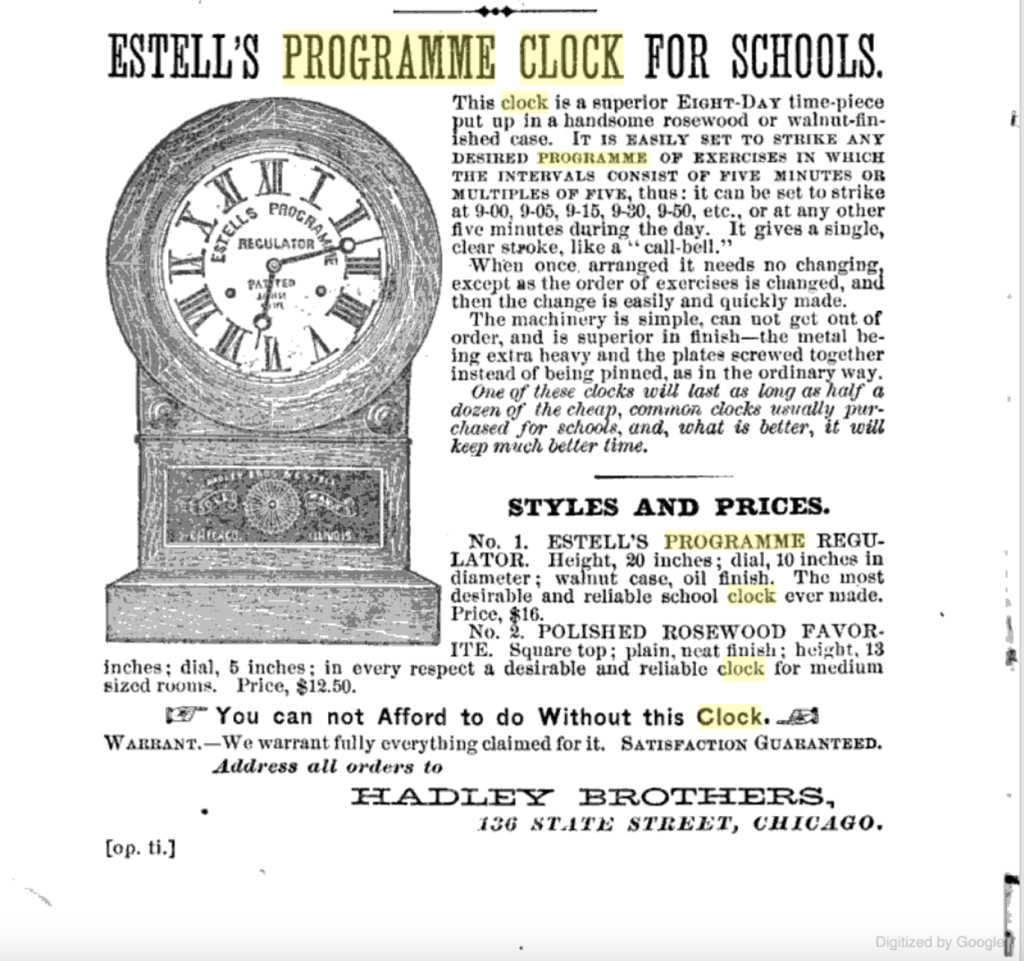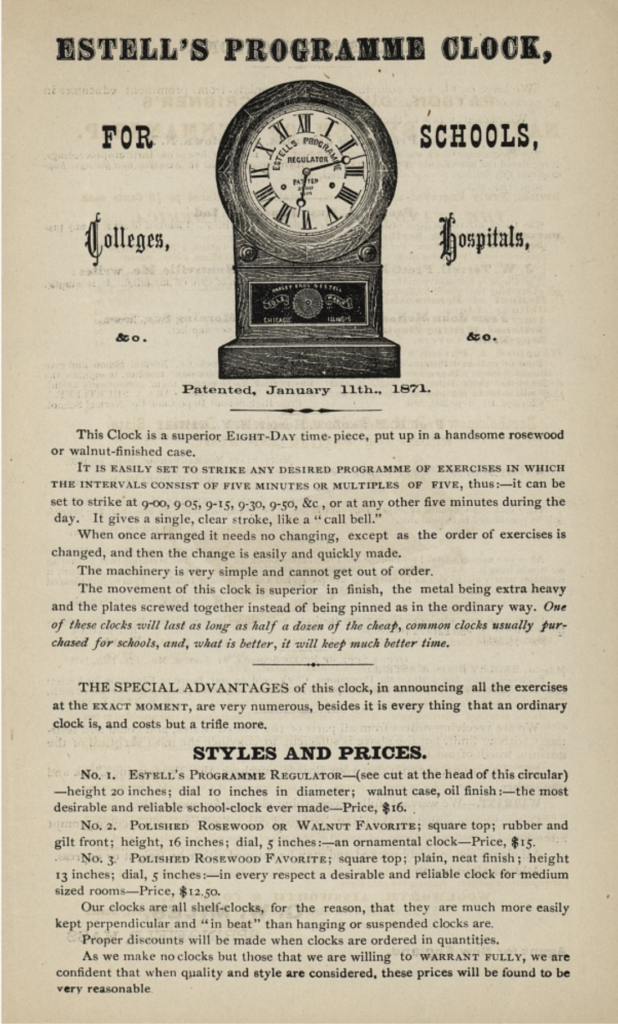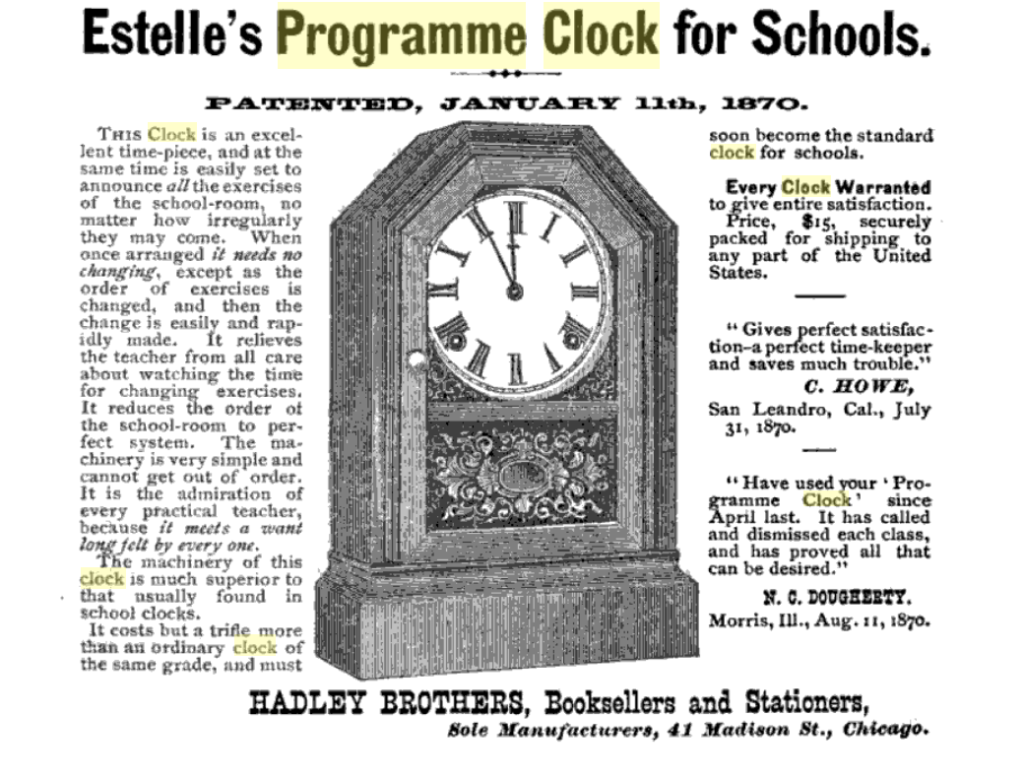The Estell Programme clock has intrigued me since I first saw one at a NAWCC Regional in Kansas City five years or so ago. There are tantalizing connections between the Estell programmable feature and both Chauncey Jerome and his son, Samuel Bryan Jerome. In Fred Linker’s article on the US Clock & Brass Co. (NAWCC Bull. No. 267, p. 356-358), he documents a similar programmable clock with a US C & B Co. label. He considers the mechanism, which uses removable pins rather than adjustable spokes, to be an early version of the one that was ultimately patented. Although I’m no further along in substantiating this, I agree with Fred that Estell was likely marketing an early, pre-patent version of his invention through the US Clock & Brass Co. Shortly before his death in 1868, Chauncey Jerome’s last involvement with the clock-making business was with the US Clock & Brass Co. Based on information gleaned from educational journal advertisements (see more below), the clock can be dated to 1871-1872.
The clock bears the label of Hadley Brothers & Estell of 41 Madison St. in Chicago, who are identified as the “Sole Manufacturers”. In addition to holding the label, the backboard has a “wallpaper” covering; a feature that is typical of shelf clocks with the labels of Jerome & Co. and often having features patented by Samuel Bryan Jerome. The particular wallpaper used in this clock is also found in Jerome & Co. clocks.
The Estell patent (#98,678), dated Jan. 11, 1870, is prominently mentioned on the label and the dial. One reason for believing there’s a connection between Estell and the US Clock & Brass Co. is the movement partially hidden by the programmable spoked wheel. The plate shape is typical of 30-hr, spring-driven movements made by the US Clock & Brass Co.
From an advertisement in the 1871 New York Teacher, the Estell patent allows the clock to be “…easily set to strike any desired programme of exercises in which the intervals consist of five minutes or multiples of five…” The clock was marketed for use in schools, colleges, and hospitals. The tablet also features the wire-spoked wheel that is at the root of Estell’s patent. The label contains the following instructions for setting the strike interval:
“…You will see a wheel containing 144 springs—one for each five minutes during the twelve hours. The springs are movable—can be left down or lifted up, and their ends placed in the small indentation beside them. When all are down the clock will strike once every five minutes. When all are up it will not strike at all.”
The 8-day movement, though unmarked, is the product of Noah Pomeroy. Both unmarked and stamped (“N. POMEROY/BRISTOL CT”) Pomeroy movements are associated with Jerome & Co. clocks. The rear view shows the programmable wheel attached to the movement.
Were it not for the large, round door frame that protects the dial, the case would bear a striking resemblance to a common Jerome & Co. case style that was used for both 30-hr and 8-day movements. See my Jerome & Co. 8-day clock and S.B. Jerome quarter-striking clock, for example. However, when casing 8-day movements, the Estell Programme version is larger at 20 3/8” tall (20 1/4” to the peak behind the door frame) by 12 5/16” wide compared to 16 3/8” by 11 3/8”. From the back, the wheel is accessible to allow programming the strike intervals. These clocks originally had a removable zinc plate covering the access hole.
There is a second patent associated with this clock. Stamped on the outer rim of the dial is “PAT JULY 5 1870”. The patent referred to is #105,077, which was invented by George Hills of Plainville, CT. The “invention” was the use of a separate piece of metal for the dial that was secured to the molded brass rim with solder and/or metal clips. This patent feature has also been seen on Jerome & Co. clocks.
The chronology of the Estell Programme clock and its association with the Hadley brothers can be pieced together through advertisements for the clock in education trade journals:
1870 Hadley Brothers, 41 Madison St. (Illinois Schoolteacher)
1871 Hadley Brothers & Estell, 41 Madison St. (New York Teacher)
1872 Hadley Brothers & Estell, 41 Madison St. (Michigan Teacher)
1872 Hadley Brothers, 136 State St. (Michigan Teacher; National Teacher)
1873 Hadley Brothers, 136 State St. (Educational Yearbook)
1873 Hadley Brothers & Kane, 136 State St. (Pennsylvania School Journal)
1874 Hadley Brothers & Kane, 136 State St. (Wisconsin Journal of Education)
Shown are a few of the advertisements. The CT School Journal describes three models:
No. 1: Estell’s Programme Regulator (the subject of this webpage)
No. 2: Polished Rosewood or Walnut Favorite, described as having a square top, with a rubber and gilt front. I believe the “rubber” referred to is actually a material patented by S.B. Jerome and often (but incorrectly) called gutta percha. See my Jerome & Co. clock for the patent drawings and specifications.
No. 3: Polished Rosewood Favorite, similar to No. 2 but slightly smaller and without the gilt.
Two other models are also known: a version shown in the Illinois Schoolteacher (pictured above) that appears to be based on a Jerome & Co. clock; and a wall clock that was marketed in the early 1880s by the New Haven Clock Co.
Chicago city directories from 1870, 1871, and 1875 contain the following listings:
1870 Hadley Bros., booksellers and stationers, 41 Madison
1871 Hadley Bros., booksellers and stationers, 41 Madison
1871 Hadley Bros. & Estell, mnfrs. Of Estell’s programme clock, 41 Madison
1875 Hadley Bros., booksellers and stationers, 63 and 65 Washington
1875 Hadley Bros. & Kane, schl. furnishers, 65 Washington
1875 Hadley Bros., school furniture, 63 and 65 Washington
Unfortunately, I wasn’t able to locate Chicago directories from 1872-74. It appears that the Hadley brothers established two separate businesses, one for selling books and stationery and the other (with Estell first and then Kane) to sell Estell programme clocks. Interestingly, though, in 1870 and 1872 (at State St), it appears that there was only the one partnership (Hadley Bros.) involved in both businesses.
While the majority of clocks with the Estell Programme feature have labels of Hadley Brothers (with or without Estell or Kane), some also have Jerome & Co. labels. These consist of shelf clocks with an 8-day Pomeroy movements or wall clocks with New Haven movements. An example of the latter is pictured in Tran’s book on the New Haven Clock Co. (from the 1881 catalog). As noted above, the label contains the claim that Hadley Brothers & Estell were the sole manufacturers of the clock. Multiple advertisements identify Hadley Brothers as being booksellers and stationers; clearly, not clock makers. A directory listing from 1875 has them as being in the school furnishing trade. Aside from the earliest version of the programme clock made by the US Clock & Brass Co., it seems that these clocks were actually made by a company using the name Jerome & Co (connected to either S.B. Jerome or New Haven). Is it possible that, when Chauncey Jerome returned to New Haven from Austin, IL in 1867, he mentioned this unique clock to his son, who then entered into a manufacturing arrangement with Hadley Brothers? Or is it possible that, after a fire in January 1868 destroyed the US Clock & Brass Co. factory in Austin, Estell and/or the Hadley brothers reached out to Chauncey Jerome prior to his death in April or even to Samuel or New Haven directly?
